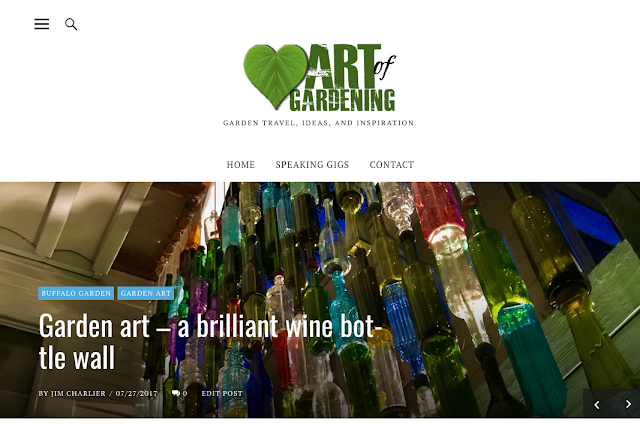Visiting northern Italy's
Gardens at Trautmansdorff Castle is different from most any botanical garden or park in that it's built on a mountainside – great views up and down like no other public garden I've ever been to. First, most botanical gardens and parks are indoors, many have rolling hills and even the occasional belvedere. I've never been to any with a natural amphitheater-type terrain with paths going up about 300 feet from its lowest point. Add in two towering overlooks and part of the fun of this park is the view of the park from up on high, as well as a good view of the surrounding Dolomites - the Italian side of the Alps.
 |
Here's a colorful hillside garden nearby the first viewing platform.
Gardeners work on ropes and harnesses to plant
on some of these near vertical slopes. |
Above is the first tower/viewing platform. you have to go through the Aviary to get out on the platform. Along with a collection of plants from around the world, the gardens have a collection of birds and other animals.
The second viewing platform (seen below in photos) was designed by a local (Merano) engineer that wanted to contribute something to the Gardens.
Trautmansdorff is considered a valuable and esteemed public tourism assert in the area of Southern Tyrol.
Most who journey to this part of Italy are there to enjoy the
spas and thermal baths (we did!), or to
visit the "Iceman" in nearby Bolazano. The Iceman is the mummified remains of a man that died around 3,300 BCE and was found in the nearby mountains in 1991. Merano's not really on the way to anything else. The nearest major airports are in Milan and Munich, Germany. You have to want to visit Merano (and if you're a garden fan, why would you
not?)
The two overlooks are a great way to get a sense of the scale of the park. And what there was left to see – which includes: Italian Garden, the Vineyard, the Maze, Sense garden, Rose garden, Botanical
Underworld multimedia show, the English Garden, Meadow Orchards, Dragonfly Clock, Beehive,
Geological Mosaic, Cottage Garden, Clematis Collection, Succulents from
the Semi-desert, The Forbidden Garden, the Lavender Field, the 700-year-old Olive Tree, the Limonaia and dozens more gardens, streams, ponds, waterfalls, plant collections, and artists pavilions.
We're just over half-way through the park at this point. I hope you were able to see/read my first two posts on the park:
and
|  |
| Looking up the mountainside is a river of perennials that can be sen for miles.
The walking paths switch back and forth through the waterfall of flowers. |
 |
| Looking down the waterfall of flowers. |
 |
Many areas of teh paths are home to plant collections. This is the hydrangea path.
We were there at a good time of the year to enjoy them. |
 |
| These triangular pillars are throughout the park with interpretive information in three languages. They turned easily so you could face the language you were most comfortable with. A full 70% of their visitors are German speaking. |
 |
| And here is Palm Beach. Palm trees grow naturally in their comfortable climate. January only gets down to an average of 53ºF. They trucked sand up to this cliffside overlook and added beach chairs! |
 |
| Cabana boys with fruity umbrella drinks would've been a nice touch. |
 |
| Not kidding when I say "cliffside." |
 |
| The second over look. It's design inspiration was a pair binoculars. |
 |
| On this one, you really feel like you're dangling over a precipice. |
 |
| And the views? More like being in an airplane than on a viewing platform. |
 |
| If you're afraid of heights. This may not be the overlook you're looking for. |
 |
| Bird's eye view of the Castle and surrounding area. |





















Comments
Post a Comment